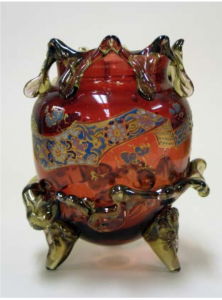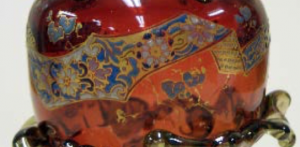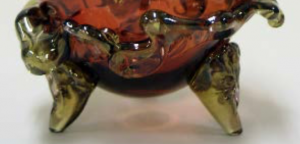 I would like to make a disclaimer before I start analyzing this piece. I went to the Ackland and took pictures, but later that day, my phone was the unfortunate victim of falling off a second-floor balcony (RIP). Unfortunately, it did not survive, and neither did the photos of this work.
I would like to make a disclaimer before I start analyzing this piece. I went to the Ackland and took pictures, but later that day, my phone was the unfortunate victim of falling off a second-floor balcony (RIP). Unfortunately, it did not survive, and neither did the photos of this work.
We had a limited selection of the glass pieces, but I was really attracted to the red color of this piece. This piece is by a French artist, Auguste Jean, around 1880. He was inspired by Japanese art when he was creating this piece. The way the piece is shaped reminded me of an actual human heart that seemed to be resting on a stand.It could possibly be that making the vase a heart shape is meant to reflect the power of life.The glass itself seems to have been pulled or blown out to make it more of an elongated, oval shape. I think that red, especially with glass, is something that is not very common. The red color also reflects the Japanese-style that the artist was aiming to create, as it is a color which is very common in Japanese artwork. It’s eye-catching and creates a unique look. The use of red glass, which is almost transparent, creates an interesting shadow when the light shines through it. A red glow surrounds the vase as the lights shine through it. The red shadow could possibly be associated with love, but the red makes the piece seem very warm. The Japanese inspiration is seen very well in the body of the piece. It has a very intricate floral design of blue and gold that look painted onto the glass.The floral detail breaks up the transparency of the glass. There is no longer a smooth look, but it is now broken into different sections where you can look through. 
The top of the vase looks like it had been blown into a bubble and then burst over the side of the vase, yet it also looks like a flower that is wilting in the vase. The style of the lip of the vase matches the legs of the vase in color and the style it was blown in. The legs and the lip compared with the body of the vase creates a unique contrast all within one piece. The body is very smooth with intricate Japanese-style decorations across it; whereas, the top and the bottom surround the smoothness with the folds created with the green and yellow colored glass. This glass sometimes catches the light in a way which creates a gold sheen to it. It illuminated the piece all around and exaggerated the gold band around the red body.
The legs appear to be attached separately, with a large seam at each of the three legs, but the lines make it look like continuous waves around the vase. Based on what we have learned about glass, it seems as if the glass was placed onto the vase, possibly with the red glass slightly warmed to create a bond, and then pulled in order to create the legs and the waves around the bottom of the glass. I feel like adding three legs is a unique choice for a vase, considering most vases have smooth and consistent lines and they are usually symmetrical. In my opinion, I consider the green glass to be similar to leaves on a flower, which could also be associated with the flower design on the body of the vase. By adding the details of the lip and the legs, it creates a fusion of the artists own personal style with the traditional styles of Japanese artwork. Rather than approprating the culture, it seems as if he took the inspirations and used close detail to create a beautiful piece of artwork that celebrated Japanese art.